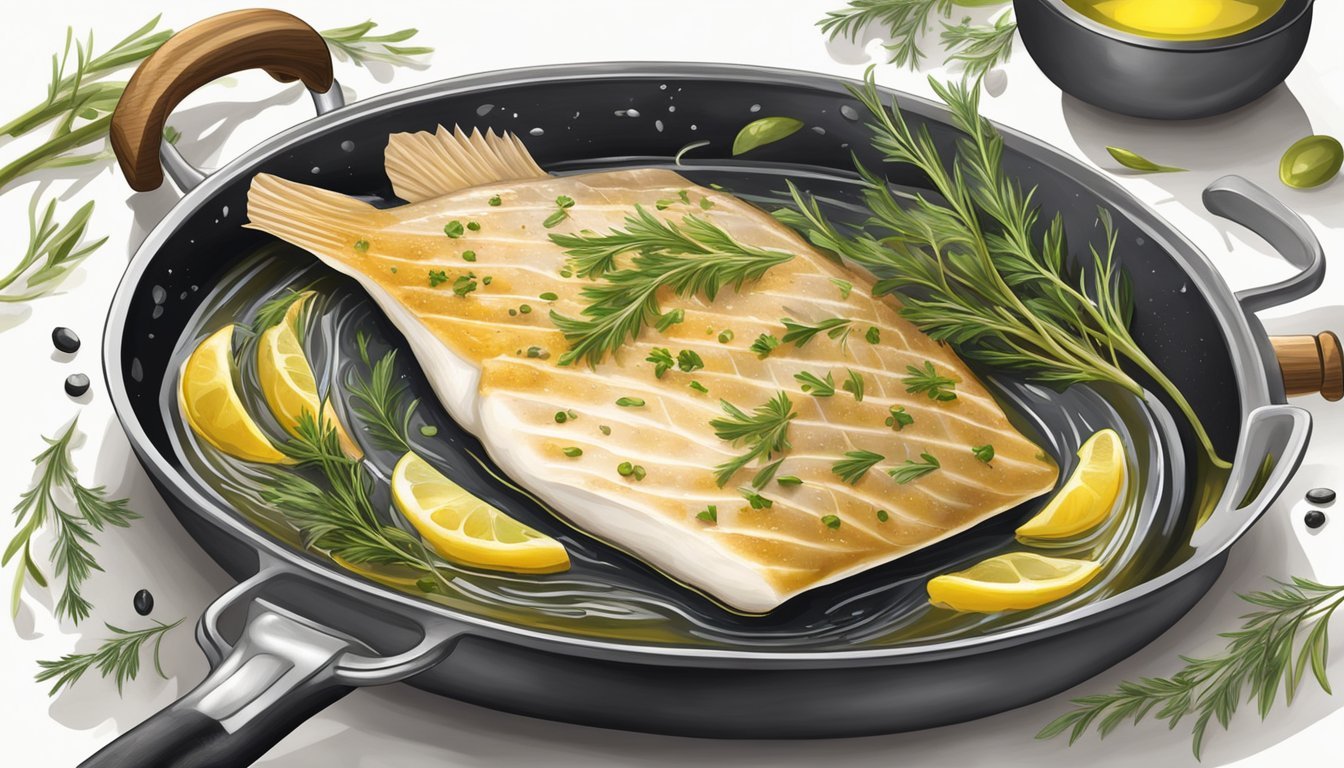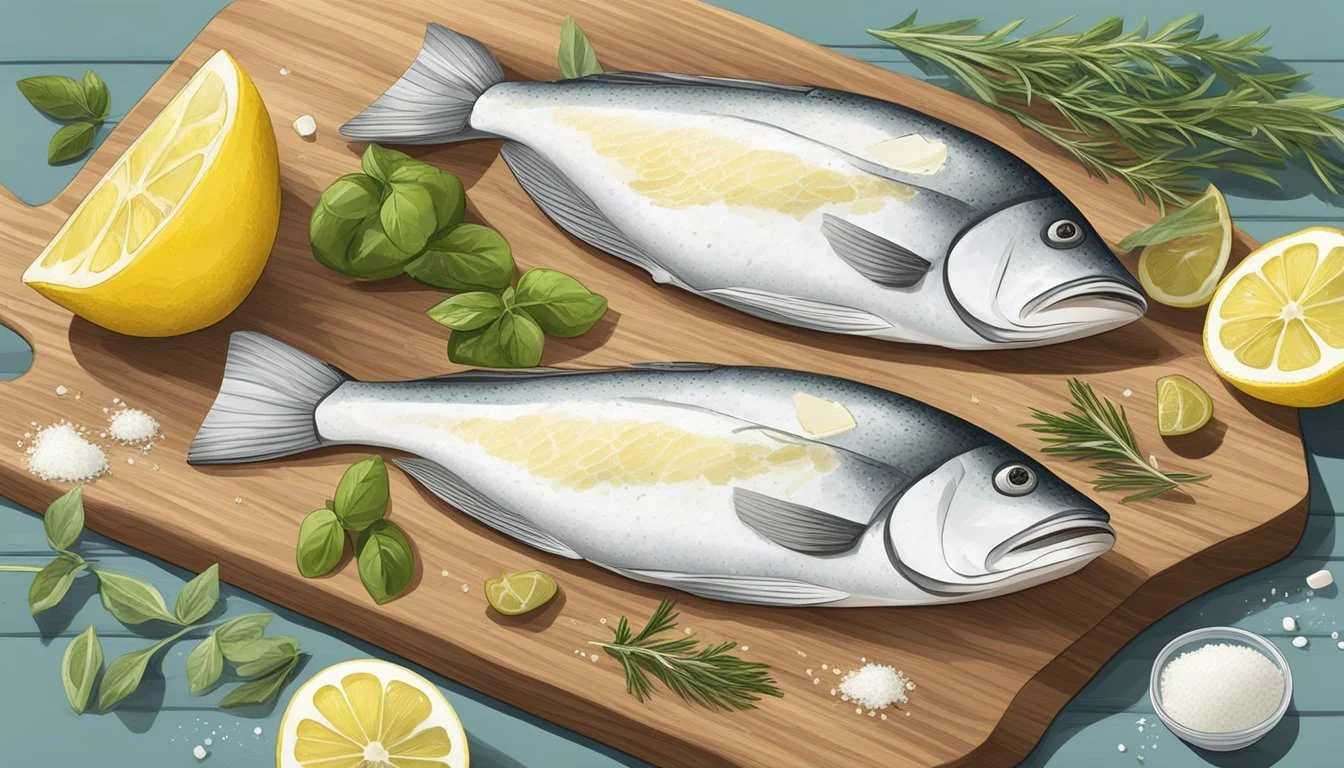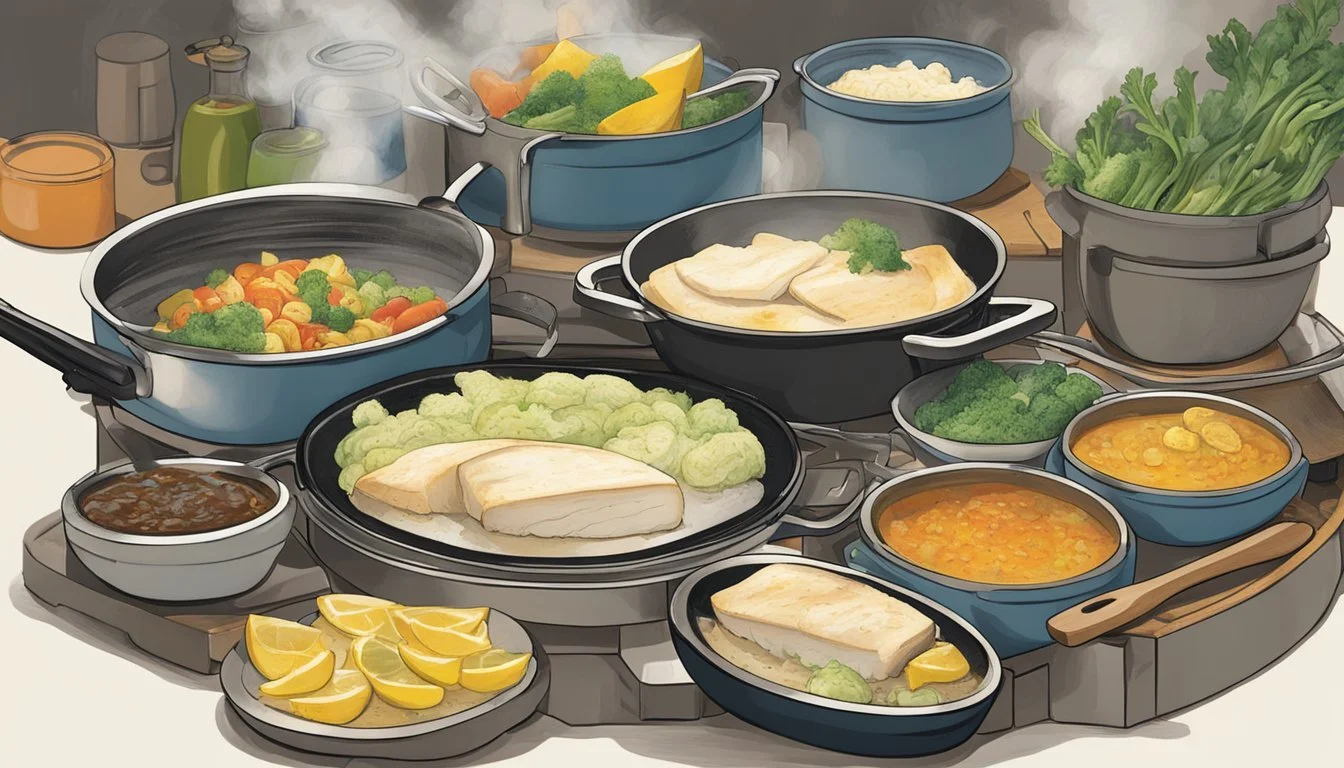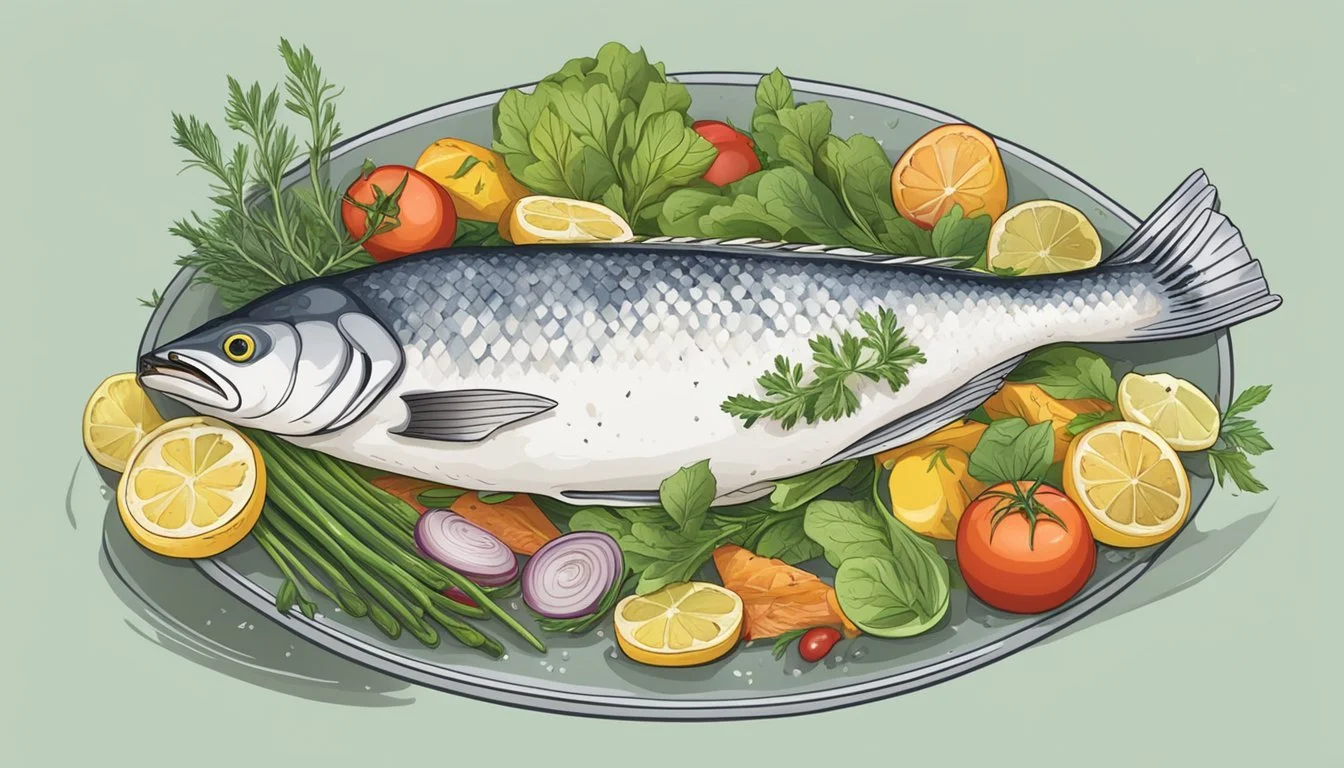How to Cook Halibut
Techniques for Perfectly Flaky and Flavorful Fish
Halibut, a prized white fish known for its delicate flavor and firm texture, offers a delightful culinary experience for seafood enthusiasts. Rich in protein and omega-3 fatty acids, this versatile fish can be prepared using various cooking methods to suit different tastes and preferences.
Cooking halibut is straightforward and quick, typically taking only 20 minutes to achieve a tender and flaky result. Popular techniques include baking, grilling, pan-searing, and roasting. Each method brings out unique qualities in the fish, from a crispy exterior when pan-seared to a moist interior when baked.
Enhancing halibut's mild taste is easy with simple ingredients like lemon, butter, herbs, and garlic. These additions complement the fish without overpowering its natural flavors. Whether served with a light sauce or seasoned with fresh herbs, halibut promises a nutritious and satisfying meal for any occasion.
Nutritional Profile and Benefits of Halibut
Halibut offers a wealth of nutritional benefits, making it an excellent choice for health-conscious seafood lovers. This fish packs a powerful punch of high-quality protein, essential vitamins and minerals, and heart-healthy omega-3 fatty acids.
Comparing Halibut to Other Fish
Halibut stands out among other popular fish varieties due to its impressive nutritional profile. A 3-ounce serving of halibut contains about 19 grams of protein, which is comparable to cod and Chilean sea bass.
Halibut has a lower fat content compared to fattier fish like salmon, making it a good option for those watching their calorie intake. It provides approximately 94 calories per 3-ounce serving.
In terms of omega-3 fatty acids, halibut contains moderate amounts, though not as high as salmon or mackerel. However, it still contributes to meeting recommended intake levels for these essential fats.
Vitamins and Minerals in Halibut
Halibut is an excellent source of several essential vitamins and minerals. It's particularly rich in selenium, providing about 47% of the daily value in a 3-ounce serving.
This fish also offers significant amounts of:
Vitamin B12: 42% of the daily value
Vitamin B6: 18% of the daily value
Niacin: 36% of the daily value
Phosphorus: 22% of the daily value
Magnesium: 18% of the daily value
These nutrients play crucial roles in various bodily functions, including energy metabolism, immune system support, and bone health.
The Role of Omega-3 Fatty Acids
While not as high in omega-3s as some other fish, halibut still provides a notable amount of these beneficial fats. Omega-3 fatty acids are essential for heart health and brain function.
Regular consumption of omega-3s from fish like halibut may help:
Reduce inflammation in the body
Lower blood pressure
Decrease triglyceride levels
Support brain health and cognitive function
The American Heart Association recommends eating fish twice a week to reap these benefits. Including halibut in your diet can contribute to meeting this recommendation and improving overall health.
Selecting Quality Halibut
Choosing high-quality halibut is crucial for a delicious meal. The fish's freshness, cut, and storage method all impact its flavor and texture.
Fresh vs. Frozen Halibut
Fresh halibut offers superior taste and texture when available. It has a firm, moist flesh and mild, sweet flavor. Fresh halibut is typically in season from March to November.
Frozen halibut is a convenient year-round option. Modern flash-freezing techniques help preserve quality. When properly thawed, frozen halibut can rival fresh in taste and texture.
For best results, thaw frozen halibut slowly in the refrigerator overnight. Avoid quick-thawing methods, as they can degrade texture.
How to Identify Freshness
Look for clear, bulging eyes and bright red gills in whole fish. The flesh should be firm and spring back when pressed. Fresh halibut has a mild sea breeze scent, not a strong fishy odor.
Check for:
Moist, shiny skin
No discoloration or browning
No dry or curling edges on fillets
Avoid fish with cloudy eyes, dull skin, or strong odors. These indicate the halibut is past its prime.
Pre-cut Fillets or Whole Fish
Pre-cut fillets offer convenience and ease of preparation. They're ideal for quick meals and specific recipes. Look for fillets with a uniform thickness for even cooking.
Whole halibut provides more versatility. It allows for custom cuts and often offers better value. Whole fish is best for those comfortable with basic filleting techniques.
Consider portion sizes when choosing. A typical serving is 6-8 ounces per person. Halibut shrinks slightly during cooking, so account for this when portioning.
Essential Ingredients and Substitutes
Preparing delicious halibut dishes requires the right combination of ingredients. Oils, seasonings, and herbs play crucial roles in enhancing the fish's natural flavor and texture.
Choosing the Right Oils and Fats
Extra virgin olive oil and butter are top choices for cooking halibut. Olive oil imparts a subtle fruity flavor and helps prevent sticking. Salted butter adds richness and a golden crust when pan-searing.
For a healthier option, use a light olive oil spray. Avocado oil is another excellent choice due to its high smoke point and neutral taste.
When baking halibut, a small amount of oil or melted butter brushed on top keeps the fish moist.
Seasonings and Flavors
Salt and pepper form the foundation of halibut seasoning. Kosher salt or sea salt are preferred for their pure flavor and texture. Freshly ground black pepper provides a subtle heat.
Garlic powder adds depth without overpowering the delicate fish. For a zesty kick, lemon zest or juice brightens the dish.
A pinch of paprika or cayenne pepper can add warmth and color. For Asian-inspired dishes, try a blend of ginger, soy sauce, and sesame oil.
Herbs for Enhancing Taste
Fresh herbs elevate halibut's mild flavor. Parsley adds a fresh, slightly peppery note and vibrant green color. Dill complements the fish with its tangy, slightly sweet taste.
Thyme and rosemary offer aromatic, earthy flavors that pair well with butter-based sauces. Chives provide a mild onion flavor and attractive garnish.
For Mediterranean-style dishes, try a combination of oregano, basil, and mint. Tarragon's subtle licorice flavor works well in creamy sauces for halibut.
Preparation Techniques
Proper preparation of halibut is crucial for achieving optimal flavor and texture. The following techniques will help ensure your halibut is ready for cooking and enhance its natural qualities.
Cleaning and Filleting
Begin by rinsing halibut fillets under cold water to remove any scales or debris. Pat dry with paper towels. If working with a whole halibut, use a sharp fillet knife to remove the skin. Cut along the backbone to separate the fillets from the frame. Remove any remaining bones with tweezers.
For skinless fillets, check for any remaining pin bones by running your fingers along the flesh. Remove these with fish bone pliers or tweezers. Trim away any dark meat, which can have a strong flavor.
Cut larger fillets into portion-sized pieces, typically 6-8 ounces each. This ensures even cooking and easier serving.
Marinating Halibut
Marinating halibut can add depth of flavor and help keep the fish moist during cooking. Create a simple marinade using extra virgin olive oil, lemon juice, and spices. Mix 1/4 cup olive oil with 2 tablespoons lemon juice, 1 minced garlic clove, and herbs like dill or parsley.
Place halibut fillets in a shallow dish and pour the marinade over them. Cover and refrigerate for 30 minutes to 2 hours. Avoid marinating for too long, as the acid in lemon juice can start to "cook" the fish.
For a quick flavor boost, brush fillets with olive oil and sprinkle with salt, pepper, and dried herbs just before cooking.
Pre-Heating and Cookware Preparation
Proper pre-heating and cookware selection are essential for cooking halibut. For pan-searing, heat a cast iron or non-stick skillet over medium-high heat. Add a thin layer of oil and heat until it shimmers.
For baking, preheat the oven to 400°F (200°C). Prepare a baking dish by lightly oiling or lining with parchment paper to prevent sticking.
If grilling, clean and oil the grates before heating to prevent the delicate halibut from sticking. Preheat the grill to medium-high heat.
For steaming, bring water to a boil in a pot with a steamer basket. Ensure the water doesn't touch the basket bottom.
Cooking Methods
Halibut's delicate flavor and firm texture make it well-suited to various cooking techniques. Each method imparts unique characteristics to the fish, allowing home cooks to create diverse and delicious meals.
Baking Halibut
Baking is a gentle, foolproof method for cooking halibut. Preheat the oven to 400°F (204°C). Pat the fillets dry and place them in a baking dish. Brush with olive oil and season with herbs, salt, and pepper. Bake for 12-15 minutes, depending on thickness, until the fish flakes easily with a fork.
For extra flavor, try a lemon butter sauce. Melt butter in a pan, add lemon juice, and drizzle over the baked fish. This technique works well for easy baked fish recipes and can be adapted for sheet pan meals with vegetables.
Pan Searing Techniques
Pan searing creates a crispy exterior while keeping the halibut moist inside. Heat a cast iron skillet over medium-high heat. Add oil and wait until it shimmers. Place the seasoned halibut in the pan, skin side down if applicable. Cook for 3-4 minutes until golden brown.
Flip the fillet and cook for an additional 2-3 minutes. For best results, avoid moving the fish too much during cooking. This method is ideal for a pan seared halibut recipe that highlights the fish's natural flavors.
Grilling for a Smoky Flavor
Grilling imparts a delicious smoky flavor to halibut. Preheat the grill to medium-high heat. Brush the grates with oil to prevent sticking. Season the halibut and place it on the grill. Cook for 4-5 minutes per side, or until it reaches an internal temperature of 145°F (63°C).
For added flavor, try marinating the halibut before grilling. A simple mixture of olive oil, lemon juice, and herbs works well. Grilled halibut pairs nicely with a variety of side dishes, from grilled vegetables to light salads.
Sauces and Accompaniments
Elevating halibut with complementary sauces and pairings enhances its delicate flavor. From zesty citrus-based options to herb-infused creations, these accompaniments add depth and dimension to the dish.
Lemon Butter Sauce
Lemon butter sauce is a classic choice for halibut. Melt unsalted butter in a pan over medium heat. Add fresh lemon juice and zest, stirring to combine. Season with salt and pepper to taste. This sauce's bright acidity cuts through the richness of the fish.
For added depth, incorporate capers into the sauce. Their briny flavor complements the lemon's tartness and the butter's richness. Drizzle the sauce over pan-seared or baked halibut just before serving.
Herb Infusions and Chimichurri
Herb-based sauces provide a fresh, vibrant accompaniment to halibut. Chimichurri, an Argentinian sauce, pairs exceptionally well with grilled halibut. Combine finely chopped parsley, oregano, garlic, red wine vinegar, and olive oil.
For a Mediterranean twist, create a basil and mint pesto. Blend the herbs with pine nuts, garlic, lemon juice, and olive oil. This verdant sauce adds a burst of flavor to baked or steamed halibut.
Wine Pairings and Reductions
White wine reductions offer a sophisticated pairing for halibut. Sauvignon Blanc or Pinot Grigio work well. Simmer the wine with shallots and herbs until reduced by half. Finish with a pat of butter for a silky texture.
For a richer sauce, try a Chardonnay cream reduction. Reduce the wine, add heavy cream, and simmer until thickened. This sauce complements pan-seared halibut with its velvety consistency.
Serve the halibut with a glass of the same wine used in the sauce for a cohesive dining experience.
Serving Suggestions
Halibut's delicate flavor pairs well with a variety of sides and garnishes. Thoughtful presentation and complementary flavors enhance the dining experience.
Pairing with Starches and Vegetables
Rice makes an excellent accompaniment to halibut. A simple steamed white rice lets the fish shine, while lemon-herb rice adds a zesty kick. For a heartier option, try wild rice or quinoa.
Roasted vegetables complement halibut beautifully. Asparagus, green beans, and cherry tomatoes are popular choices. Toss them with olive oil, salt, and pepper before roasting.
Potatoes offer a satisfying starch option. Roasted baby potatoes or a light potato salad work well. For a lower-carb alternative, consider cauliflower rice or mashed cauliflower.
Creating Balanced Meal Plates
Start with a portion of halibut as the centerpiece. Add a starch like rice or potatoes to one side of the plate.
Fill the remaining space with colorful vegetables. Mix cooked and raw options for variety in texture and temperature.
A small side salad adds freshness. Try mixed greens with a light vinaigrette or a cucumber and tomato salad.
Consider texture when planning the meal. Pair the tender fish with crisp vegetables or a crunchy slaw for contrast.
Garnishing for Presentation
Fresh herbs elevate the visual appeal and flavor of halibut. Sprinkle chopped parsley, dill, or thyme over the fish just before serving.
Lemon is a classic garnish for halibut. Place lemon wedges on the plate or sprinkle lemon zest over the dish for a bright pop of color and flavor.
Microgreens make an elegant garnish. A small handful adds a delicate texture and subtle flavor to the plate.
For a finishing touch, drizzle a sauce around the plate. A light butter sauce or herb oil creates an appealing visual and adds flavor.
Storage and Reheating
Proper storage and reheating techniques are crucial for maintaining the quality and safety of cooked halibut. These methods help preserve flavor, texture, and nutritional value while preventing foodborne illness.
Proper Refrigeration
Store cooked halibut in an airtight container or wrapped tightly in plastic wrap or aluminum foil. Place it in the coldest part of the refrigerator, typically the back of the bottom shelf. Consume refrigerated halibut within 3-4 days for optimal quality and safety.
Always label containers with the date of storage to track freshness. Keep the refrigerator temperature at or below 40°F (4°C) to slow bacterial growth. Avoid storing halibut near raw meats or strong-smelling foods to prevent cross-contamination and odor absorption.
Use a meat thermometer to check the internal temperature of leftover halibut before consuming. It should reach 165°F (74°C) to ensure safety.
Reviving Leftover Halibut
Oven reheating is the best method for maintaining halibut's texture and flavor. Preheat the oven to 275°F (135°C). Place the fish in an oven-safe dish with a splash of water or broth. Cover with foil and heat for 10-15 minutes or until internal temperature reaches 165°F (74°C).
For quicker results, use an air fryer. Set it to 350°F (175°C) and reheat for 3-4 minutes, checking frequently to avoid overcooking. Microwave reheating is the fastest option but may result in uneven heating and drier texture. Use 50% power in 30-second intervals, checking temperature between each interval.
Add a squeeze of lemon juice or a drizzle of olive oil before serving to enhance flavor and moisture.
Freezing Cooked Halibut
To freeze cooked halibut, wrap it tightly in plastic wrap, then place in a freezer-safe bag or container. Remove as much air as possible to prevent freezer burn. Label with the date and contents.
Frozen cooked halibut maintains quality for up to 3 months. Thaw in the refrigerator overnight before reheating. Avoid refreezing previously frozen halibut to maintain food safety and quality.
For best results, use vacuum-sealed bags to minimize air exposure. Consider freezing individual portions for easier thawing and reheating. Always reheat frozen halibut to an internal temperature of 165°F (74°C) before consuming.
Tips for Perfect Halibut Every Time
Mastering halibut preparation requires attention to detail and proper technique. These essential tips will help you achieve a perfectly cooked, flavorful fish dish every time.
Achieving the Right Doneness
Halibut cooks quickly and can easily dry out if overcooked. Aim for a moist, flaky texture with an opaque center. Cook halibut until it reaches an internal temperature of 130°F to 135°F. At this point, the fish will be cooked through but still tender and juicy.
Remove the halibut from heat when it's slightly undercooked, as it will continue to cook for a few minutes after being taken off the heat source. This carryover cooking ensures the fish reaches the ideal doneness without becoming dry or tough.
For a simple weeknight meal, try pan-searing halibut fillets. Heat a non-stick skillet over medium-high heat, add a small amount of oil, and cook the fish for 3-4 minutes per side.
Utilizing a Meat Thermometer
A meat thermometer is an invaluable tool for cooking halibut perfectly. Insert the thermometer into the thickest part of the fish to get an accurate reading. This method eliminates guesswork and ensures consistent results.
Digital instant-read thermometers are particularly useful for halibut, as they provide quick and accurate readings. Avoid repeatedly piercing the fish, as this can cause moisture loss.
When using a thermometer, be careful not to touch the pan or cooking surface, as this will give an inaccurate reading. For best results, check the temperature in multiple spots to ensure even cooking throughout the fillet.
Adjusting Cooking Time Based on Thickness
The thickness of halibut fillets can vary significantly, affecting cooking time. As a general rule, allow about 10 minutes of cooking time per inch of thickness. Thinner fillets may only need 6-8 minutes total, while thicker cuts could require up to 15 minutes.
For even cooking, choose fillets of uniform thickness or adjust their position on the heat source. Place thicker portions towards the hotter areas of the grill or pan.
When baking halibut, use a hot oven (400°F to 425°F) for quicker, more even cooking. This high heat helps seal in moisture and creates a lightly browned exterior. Check the fish frequently to prevent overcooking.
Health and Dietary Considerations
Halibut offers a range of nutritional benefits while fitting well into various dietary plans. Its lean protein content and omega-3 fatty acids make it a healthful choice for many.
Halibut in Dietary Plans
Halibut is an excellent protein source for those following low-fat or low-carb diets. It contains approximately 20 grams of protein per 3-ounce serving, making it ideal for muscle maintenance and growth.
The fish is naturally low in calories, with about 94 calories per 3-ounce portion. This makes it suitable for weight management diets.
Halibut's high omega-3 content (around 490 milligrams per serving) supports heart health, aligning with Mediterranean and anti-inflammatory diet recommendations.
Allergies and Sensitivities
Fish allergies can be severe, and individuals with known fish allergies should avoid halibut. Cross-contamination risks exist in seafood processing facilities.
Some people may experience mild digestive discomfort when consuming halibut, particularly if they're not accustomed to eating fish regularly.
Always consult a healthcare provider before introducing new foods, especially for those with existing food sensitivities or allergies.
Balancing Nutrition with Taste
Halibut's mild flavor makes it versatile for various cooking methods. Grilling, frying, and pan-searing can enhance taste while maintaining nutritional value.
To maximize health benefits, pair halibut with vegetables and whole grains. This combination provides a well-rounded meal rich in fiber, vitamins, and minerals.
Cooking methods like steaming or baking with minimal added fats help preserve halibut's natural nutritional profile. Lemon juice or herbs can add flavor without excessive calories.
Halibut is rich in selenium, vitamin B6, vitamin B12, and niacin. These micronutrients support immune function, energy metabolism, and overall health.
Alternatives to Halibut
Several fish can serve as excellent substitutes for halibut in recipes. These alternatives offer similar textures and flavors while often being more readily available or budget-friendly options.
Substituting Halibut in Recipes
When replacing halibut in a recipe, consider fish with comparable characteristics. Cod is a popular choice due to its mild flavor and flaky texture. Chilean sea bass offers a buttery taste and firm texture, making it suitable for grilling or baking. Haddock provides a slightly sweet flavor and can be used in various cooking methods.
For recipes calling for baked halibut, try using salmon. While salmon has a distinct flavor, its texture works well in many halibut dishes. Adjust cooking times as needed, as salmon may cook faster than halibut.
When substituting, maintain similar portion sizes and cooking methods to ensure the best results. Be mindful of the alternative fish's flavor intensity and adjust seasonings accordingly.
Considering Other White Fish
Several white fish options can stand in for halibut. Striped bass has a mild flavor and medium texture, suitable for various cooking methods. Sole offers a delicate, sweet taste and works well in elegant dishes.
Tilapia is an affordable option with a mild flavor and flaky texture. It's versatile and can be prepared using methods similar to halibut. Swordfish, while not a white fish, provides a meaty texture comparable to halibut and holds up well to grilling.
Dogfish fillets offer a subtly sweet flavor and firm texture. They can withstand high cooking temperatures, making them suitable for grilling, baking, or frying.
When to Choose a Different Fish
Sometimes, it's best to opt for a fish with different characteristics than halibut. If a recipe relies heavily on halibut's specific taste or texture, consider modifying the dish entirely rather than using a substitute.
For dishes where halibut's firm texture is crucial, such as fish tacos or kebabs, choosing a similarly firm fish like mahi-mahi or swordfish may be preferable. In contrast, for delicate preparations like poaching, a softer fish like cod or haddock might be more appropriate.
Consider the cooking method when selecting an alternative. Some fish may not hold up well to certain techniques, such as grilling or pan-searing. Always adjust cooking times and temperatures based on the chosen substitute's characteristics.










